Caseasauria
|
The Synapsida is one of the two major subdivisions of amniote tetrapods (the other is the Sauropsida, the reptiles & birds). Technically, mammals are part of the Synapsida clade, but here we will examine only the non-mammalian synapsids, or "proto-mammals," technically a paraphyletic grouping. Over time, the synapsids tended to gradually evolve to be more mammal-like and less reptilian in a series of changes, so to simplify, many of the groupings covered here are paraphyletic as well.
Caseasauria is a basal clade of synapsids that forms a sister group to the pelcyosaurs plus all other synapsids. They, like the pelycosaurs, are anatomically more reptile-like than the Therapsids and other derived synapsids.
Ennatosaurus tecton was an herbivore (note the peg-like teeth). Cast of a partially crushed skull.
Taxonomy: Amniota; Synapsida; Caseasauria; Caseidae
Pinega, Russia
Late Permian Period
Arizona Museum of Natural History
|

|
|
|
Casea broilii reconstructed skeleton of this small (1.2 m long) herbivore
Taxonomy: Amniota; Synapsida; Caseasauria; Caseidae
Texas
Early Permian Period
Chicago Field Museum
|

|
|
Pelycosaurs
|
"Pleycosaur" is a paraphyletic grouping of the more primitive proto-mammals (synapsids), that has sometimes also included the Caseasauria (above). They generally have a more reptile-like features, including simple teeth, a sprawling posture and long tail.
Dimetrodon sp. is one of the besk known pelycosaurs and was a carnivore or possibly a fish-eater. The function of its sail is unknown, but may have been for thermoregulation or social/sexual display.
Taxonomy: Amniota; Synapsida; Eupelycosauria; Sphenacodontia; Sphenacodontidae
North America, Europe
Permian Period, 280-265 Ma
Museum of Ancient Life, Utah
|

|
|
|
Dimetrodon limbatus with its contemporary, Eryops megacephalus.
Taxonomy: Synapsida; Eupelycosauria; Sphenacodontia; Sphenacodontidae
Admiral Formation, Archer Co., TX
Early Permian Period, 275 Ma
Denver Museum of Science & Nature
|

|
|
|
Cast of a juvenile Dimetrodon sp.
Taxonomy: Synapsida; Eupelycosauria; Sphenacodontia; Sphenacodontidae
Southwest Texas
Early Permian Period
Arizona Museum of Natural History
|

|
|
|
Sphenacodon ferox reconstructed skeleton. This predator is closely related to Dimetrodon, but lacks the tall sail.
Taxonomy: Synapsida; Eupelycosauria; Sphenacodontia; Sphenacodontidae
New Mexico
Permian Period
Chicago Field Museum
|
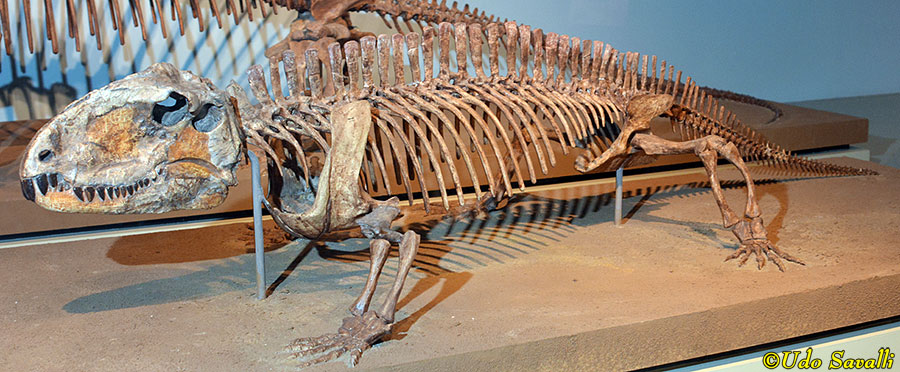
|
|
|
Although Edaphosaurus sp. superficially resembles Dimetrodon because they both have a sail, they are not especially closely related and evolved their sails independently. Edaphosaurus was an herbivore.
Taxonomy: Synapsida; Eupelycosauria; Sphenacodontia; Edaphosauridae
Texas
Permian Period
Black Hills Institute Museum, South Dakota
|

|
|
|
Edaphosaurus pogonias reconstructed skeleton. The function of the lateral cross-bars off the tall neural spines is unknown.
Taxonomy: Synapsida; Eupelycosauria; Sphenacodontia; Edaphosauridae
Texas
Permian Period
Chicago Field Museum
|
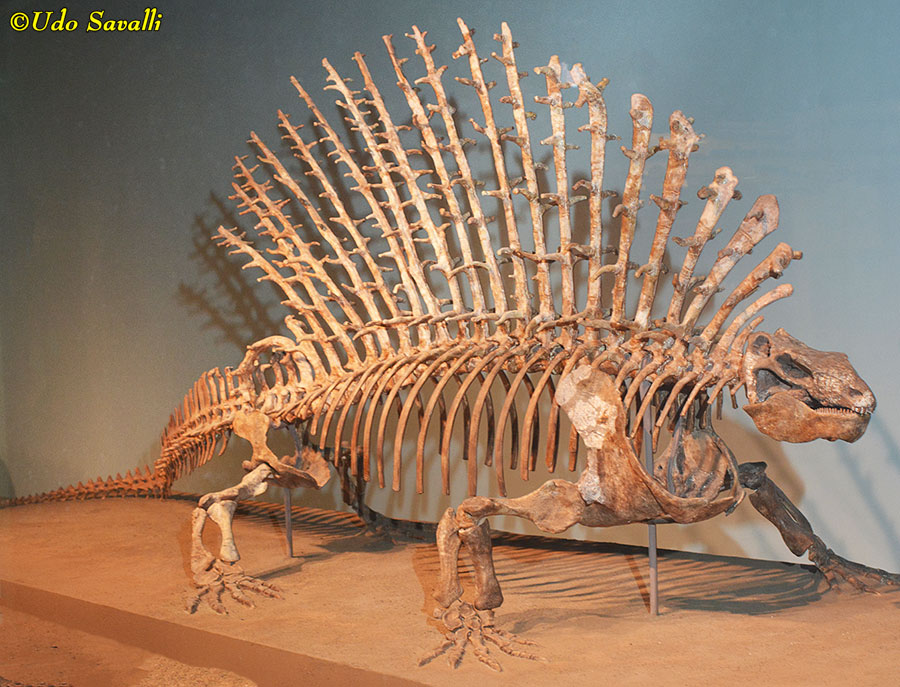
|
|
|
Life model of Ianthasaurus sp., a close relative of Edaphosaurus.
Taxonomy: Synapsida; Eupelycosauria; Sphenacodontia; Edaphosauridae
Carboniferous Period, late Pennsylvanian Epoch, 295 Ma; Kansas
Denver Museum of Science & Nature
|

|
|
|
Ophiacodon mirus reconstructed skeleton.
Taxonomy: Synapsida; Eupelycosauria; Ophiacodontidae
Rio Arriba Co., NM
Permian Period
Chicago Field Museum
|

|
|
|
Varanops brevirostris reconstructed skeleton. The phylogenetic position of Varanops and its relatives has been debated, but most recent studies suggest it is a pelycosaur, although were exactly it fits in among the other pelycosaurs is not clear. It was a 1.2 m long lizard-like predator.
Taxonomy: Synapsida; Eupelycosauria; Varanopidae
Texas
Early Permian Period
Chicago Field Museum
|

|
|
|
Aerosaurus wellesi cast of holotype fossil.
Taxonomy: Synapsida; Eupelycosauria; Varanopidae
Abo Cutler Formation, NM
Wolfcampian Stage, Early Permian Period
Arizona Museum of Natural History
|
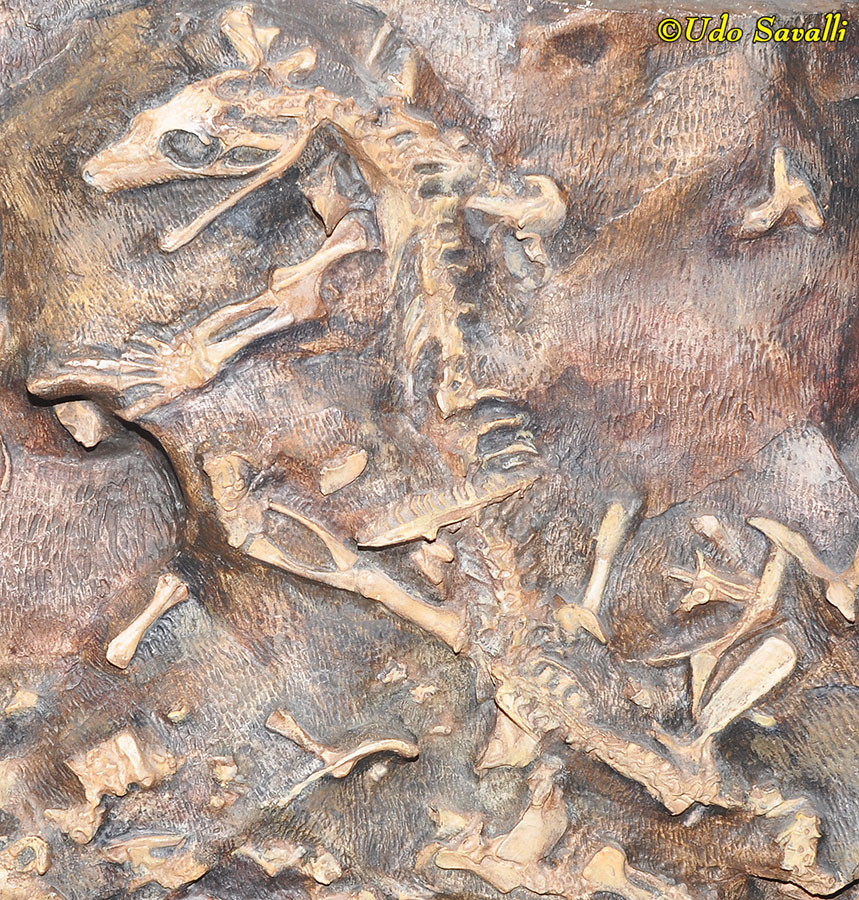
|
|
Therapsids
|
Therapsids are intermediate in the transition from the more reptile-like pelycosaurs to the mammals. Compared to the pelycosaurs, they generally have a more upright posture, shorter tail, and more varied teeth. They have varied biology, from herbivores to carnivores.
Biarmosuchus tener is a member of the basal therapsid clade Biarmosuchia; it was likely carnivorous.
Taxonomy: Synapsida; Therapsida; Biarmosuchia
Ocher, Russia
Late Permian Period
Arizona Museum of Natural History
|

|
|
|
Eotitanosuchus olsoni skull cast.
Taxonomy: Synapsida; Therapsida; Biarmosuchia
Ocher, Russia
Late Permian Period
Arizona Museum of Natural History
|

|
|
|
The Dinocephalia was a clade of relatively large, thick-headed therapsids that were still rather primitive. Their diet varied, from herbivorous to omnivorous to carnivorous.
Estemmenosuchus mirabilis was likely an herbivore. The horns were larger and more developed in males.
Taxonomy: Synapsida; Therapsida; Dinocephalia; Estemmenosuchidae
Ocher, Russia
Late Permian Period
Arizona Museum of Natural History
|

|
|
|
Skull of Jonkeria truculenta, missing teeth and mandible. It was a large omnivore that may have been semi-aquatic.
Taxonomy: Synapsida; Therapsida; Dinocephalia; Titanosuchidae
South Africa
Permian Period
Chicago Field Museum
|
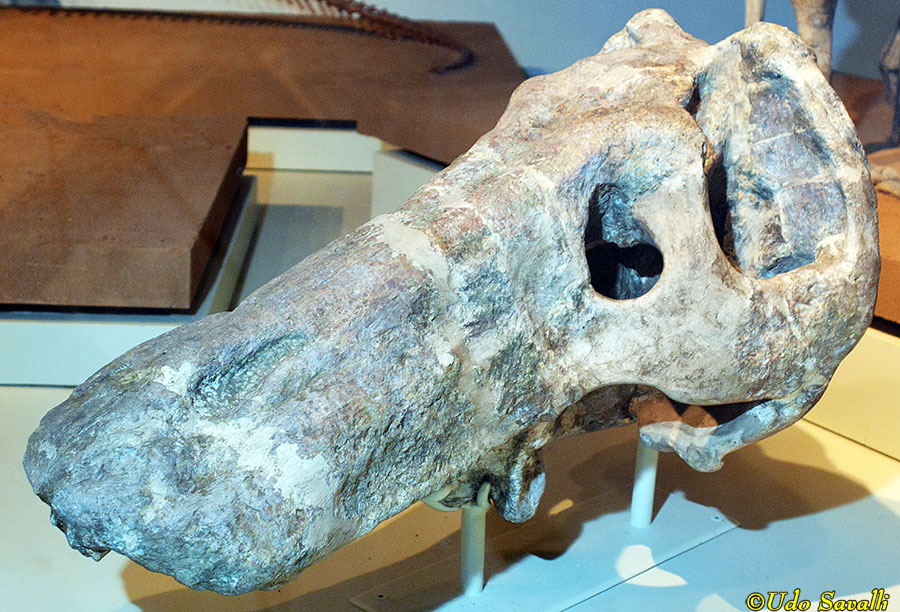
|
|
|
The Dicynodontia was a clade of relatively derived herbivorous therapsids. They had a pair of tusks (enlarged teeth) and most had a beak at the end of their snout.
Placerias hesternus (skeleton cast) was a cow-sized herbivore.
Taxonomy: Synapsida; Dicynodontia; Kannemeyeriidae
Chinle Group, Blue Water Creek Formation, Arizona
Late Triassic Period, 220 Ma
Petrified Forest National Park
|

|
|
|
Life model of Placerias sp.
Taxonomy: Synapsida; Therapsida; Dicynodontia; Kannemeyeriidae
Late Triassic Period; Arizona
Arizona Museum of Natural History
|

|
|
|
Dicynodon sp. cast skeleton. It was an herbivore that was toothless except for the two tusks, which may have been used to dig up roots
Taxonomy: Synapsida; Therapsida; Dicynodontia; Lystrosauridae
Permian Period, 280-265 Ma
Museum of Ancient Life, Utah
|

|
|
|
Lystrosaurus sp. is one of the most common dicynodonts. They survived the end-Permian mass extinction and briefly flourished in its aftermath.
Taxonomy: Synapsida; Therapsida; Dicynodontia; Lystrosauridae
Early Triassic Period, 250 Ma
Wyoming Dinosaur Center
|

|
|
|
Lystrosaurus sp. skull
Taxonomy: Synapsida; Therapsida; Dicynodontia; Lystrosauridae
Early Triassic Period, 250 Ma
Wyoming Dinosaur Center
|
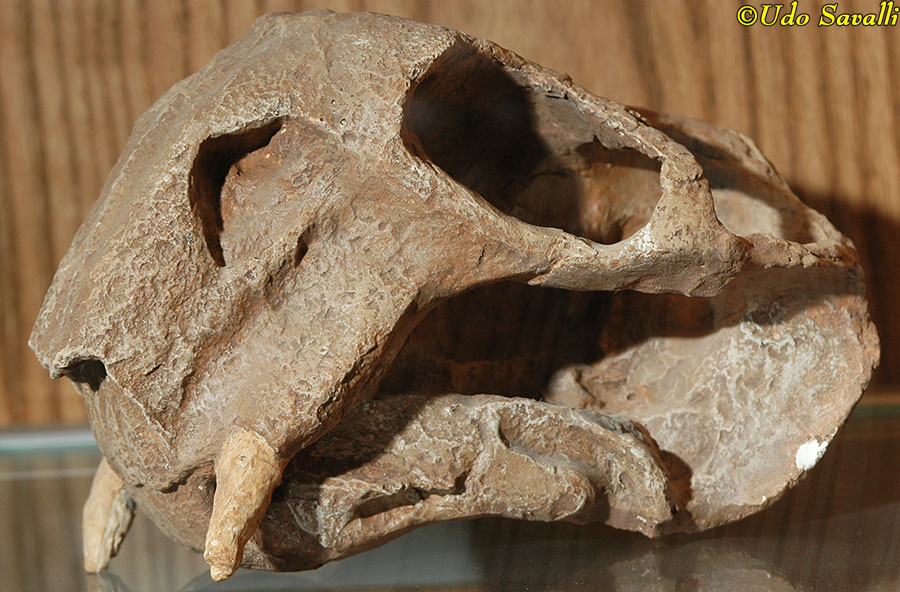
|
|
|
Aulacephalodon peavoti reconstructed skeleton. It was a medium-sized herbivore.
Taxonomy: Synapsida; Therapsida; Dicynodontia; Geikiidae
South Africa
Late Permian Period
Chicago Field Museum
|
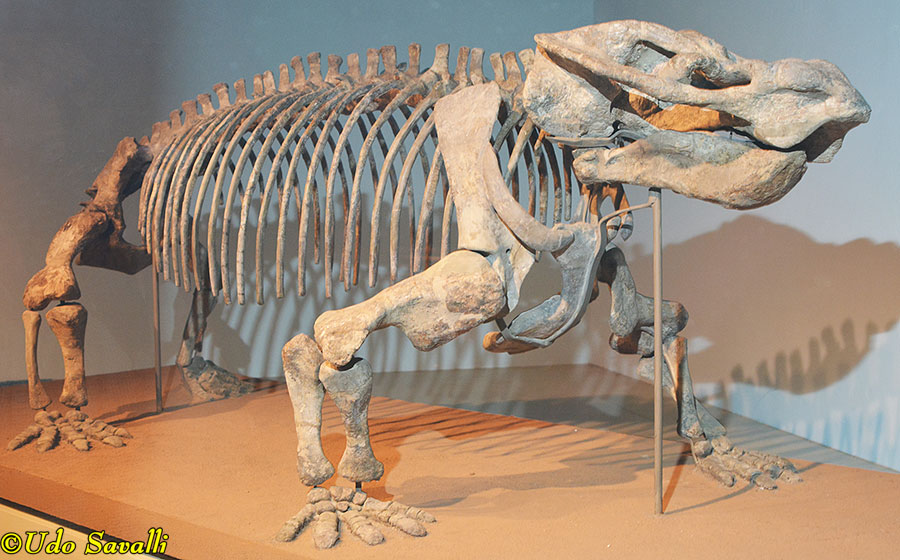
|
|
|
Oudenodon partial fossil.
Taxonomy: Synapsida; Therapsida; Dicynodontia; Oudenodontidae
South Africa
Late Permian Period
Chicago Field Museum
|

|
|
|
Diictodon sp. skull was, like all dicynodonts, an herbivore.
Taxonomy: Synapsida; Therapsida; Dicynodontia; Dicynodontidae
South Africa
Late Permian Period, 260 Ma
Wyoming Dinosaur Center
|

|
|
|
The clade Theriodontia is a derived group of synapsids that were more mammal-like than other therapsids, with varied teeth. Some may have been endothermic. Most were carnivorous.
Inostrancevia alexandri was a large, carnivore.
Taxonomy: Synapsida; Therapsida; Theriodontia; Gorgonopsia; Gorgonopsidae
Sokolki, Russia
late Permian Period
Arizona Museum of Natural History
|

|
|
|
Skull of Lycaenops angusticeps.
Taxonomy: Synapsida; Therapsida; Theriodontia; Gorgonopsia; Gorgonopsidae
South Africa
Late Permian Period, 260 Ma
Chicago Field Museum
|
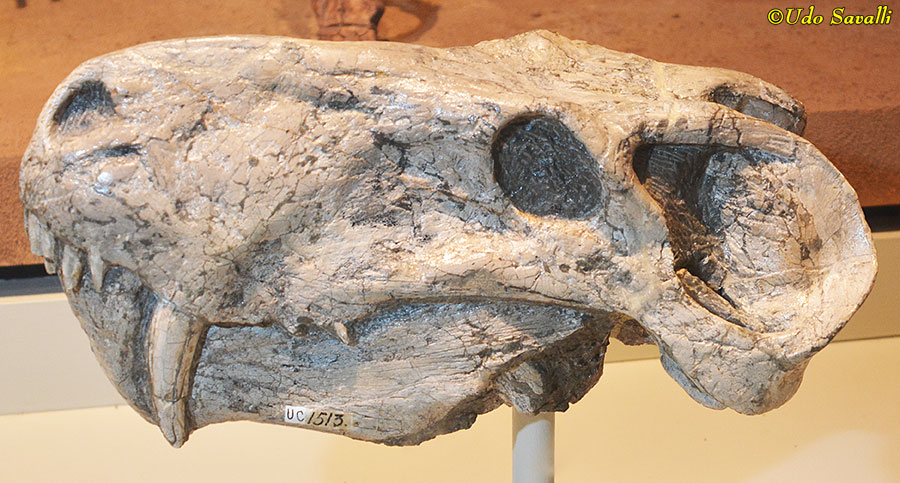
|
|
|
Skull of Cyonosaurus longiceps.
Taxonomy: Synapsida; Therapsida; Theriodontia; Gorgonopsia; Gorgonopsidae
South Africa
Late Permian Period,
Chicago Field Museum
|
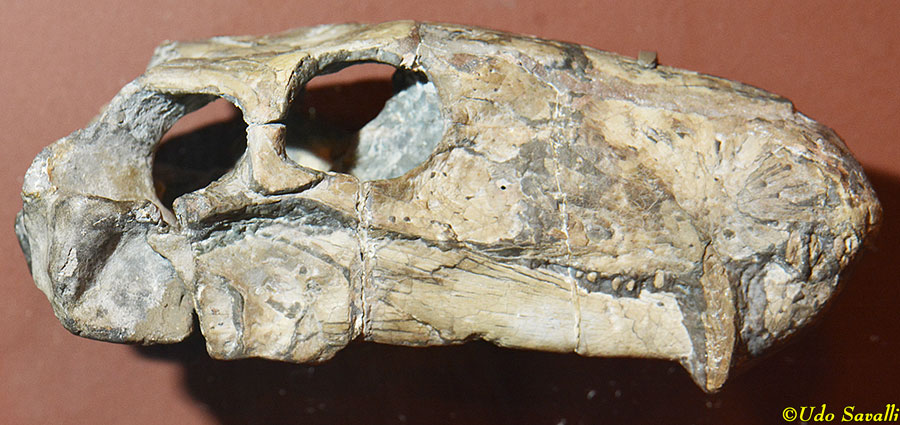
|
|
|
Skull of Lycosuchus vanderrieti, another theriodontian. Note the three different types of teeth, a characteristic shared with mammals.
Taxonomy: Synapsida; Therapsida; Theriodontia; Therocephalia; Lycosuchidae
Abrahamskraal Formation, southern Africa
late Permian Period, 265-245 Ma
Museum of Ancient Life, Utah
|

|
|
Cynodonts
|
The Cynodontia are the most mammal-like of the non-mammalian therapsids, and represent transitional forms in the evolution towards true mammals. While we have no direct evidence, it is likely they had hair and some may have suckled their young.
Cast of a Kayentatherium sp. skull.
Taxonomy: Synapsida; Therapsida; Cynodontia; Tritylodontidae
Kayenta Formation, Arizona
Early Jurassic Period, 195 Ma
Dinosaur Discovery Site at Johnson Farm, Utah
|

|
|
|
Chiniquodon kalanoro, cast of partial fossil.
Taxonomy: Synapsida; Therapsida; Cynodontia; Chiniquodontidae
Madagascar
Middle Triassic Period, 242-227 Ma
Chicago Field Museum
|
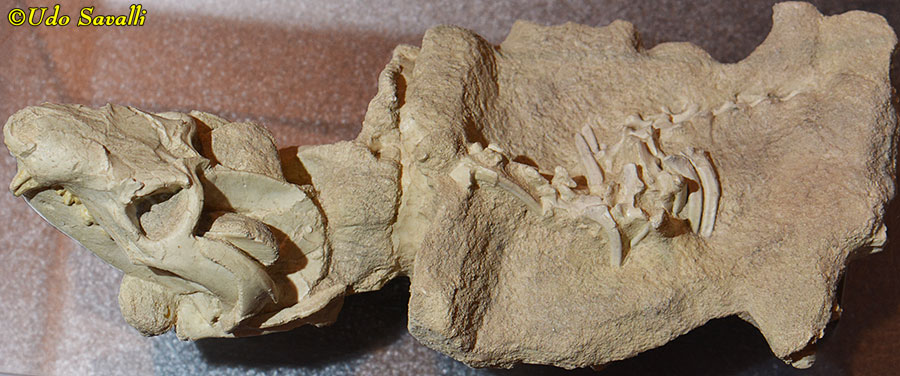
|
|
|
Chiniquodon kalanoro life model.
Taxonomy: Synapsida; Therapsida; Cynodontia; Chiniquodontidae
Madagascar
Middle Triassic Period, 242-227 Ma
Chicago Field Museum
|
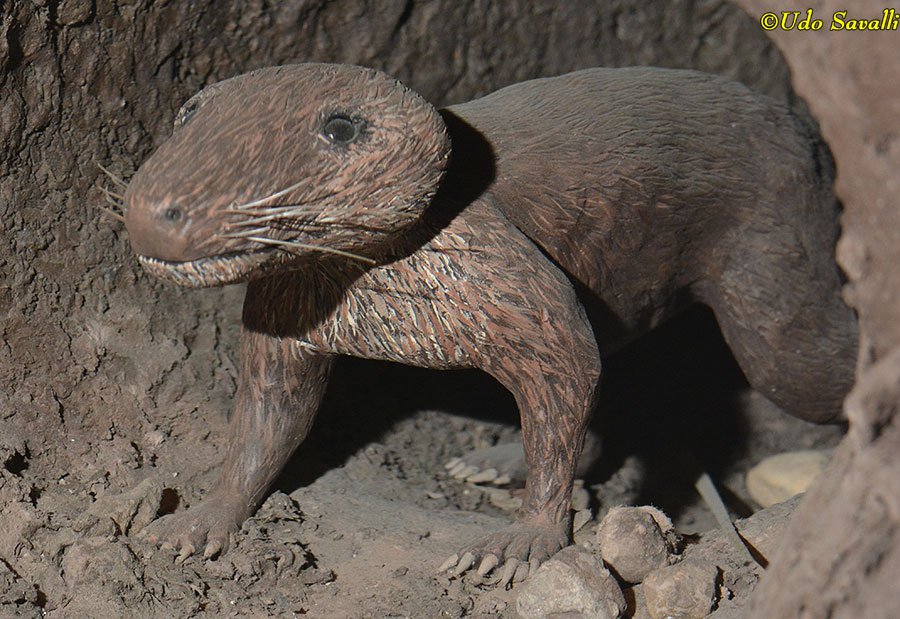
|
|
|
Adelobasileus cromptoni, known only from this tiny 17mm long skull, was transitional between the rest of the cynodonts and the very first mammals. It was either the common ancestor to all mammals or closely related to the common ancestor.
Taxonomy: Synapsida; Therapsida; Cynodontia; Mammaliamorpha
Texas
Late Triassic Period, 225 Ma
New Mexico Museum of Natural History & Science
|

|
|
|































